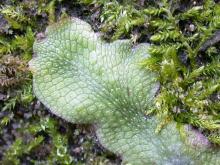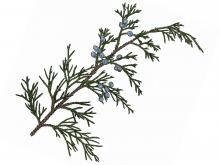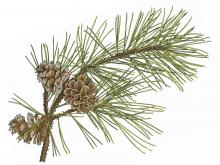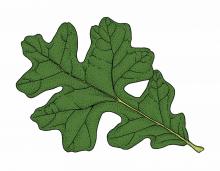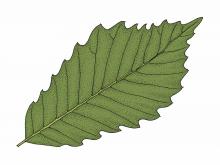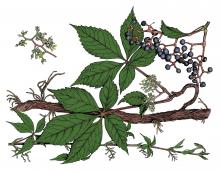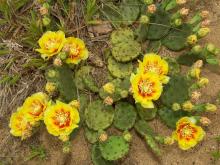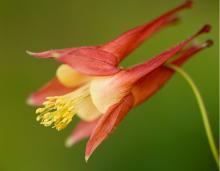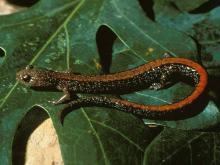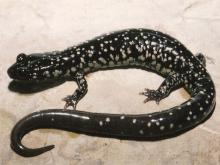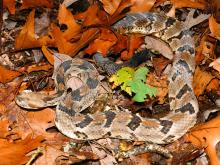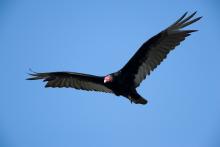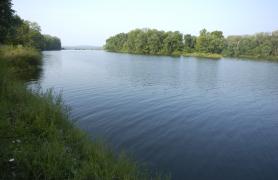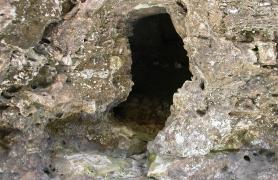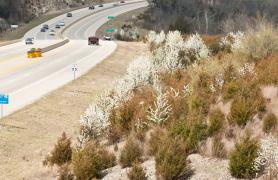
In Missouri, cliffs can reach as high as 550 vertical feet. Most cliffs occur through the following processes:
- As an escarpment created by erosion or faulting, separating two fairly level or gently sloping surfaces
- Above high-gradient streams and large river floodplains
- As a part of karst landforms, including sinkholes and the chasms made by collapsed caves
Cliffs often include features such as rock shelters, shelter caves, and overhangs. In Missouri, many of our dry caves occur as openings in cliffs, evidence of where a spring outlet once occurred.
Talus slopes, a distinct type of natural community, often occur at the bases of cliffs, where rocks have broken off of the cliff face.
Cliff Architecture
A cliff is generally divided into three parts, amounting to top, bottom, and middle:
1. The cliff edge is a level or sloping plain at the top of a cliff, extending back from the cliff face. It is excessively drained and extremely dry. The soils are very thin. Vegetation amounts to stunted woodland or grassland types. Xeric (dry-loving) and drought-tolerant plants are common: winter annuals, mosses, and lichens, as well as perennial wildflowers and annual grasses.
2. The pediment is the base rock at the bottom of the cliff. Many plants thrive at the bases of cliffs, where they may receive relatively abundant water and may enjoy especially warm (south-facing) or cool (north-facing) microclimates. Often a talus community forms near the cliff base.
3. The cliff face is the precipitous section of rock between the top and bottom. There are virtually no soils on this part of a cliff. Soils accumulate only on ledges and shelves of the rock. The plants that eke out a living in the steep or vertical face tend to be long-lived perennial forms: trees, shrubs, vines, and ferns.
Bluffs
Although any cliff with a broad, steep face may be called a bluff, the term bluff refers to a high bank or bold headland with a broad, precipitous, sometimes rounded cliff face. Bluffs can overlook either a plain or a body of water, especially on the outside curve of a stream meander.
Roadcuts
As human-made habitats, rocky roadcuts cannot be considered the same as natural cliffs, even though they have steep, rocky faces and thin soils, and undergo the same types of natural processes (such as rock fragmenting from freezing and thawing, rapid rain runoff, hot exposures when facing south, etc.).
In addition to being human-made habitats, roadcuts occur next to roadways and railroads. Natural cliffs were produced by natural geological processes, often over millions of years, and they usually occur next to rivers and streams, forests, woodlands, and other biologically rich habitats. Of course, highways and railroads can skirt the edge of natural cliffs, too. Newer rock cuts can usually be identified by the vertical drill marks left by the blasting procedure.
Cliff Plants
Cliff vegetation is usually sparse. Plants associated with cliffs include trees, shrubs, vines, ferns, perennial wildflowers, lichens, liverworts, and mosses. The trees are often stunted and gnarled and can be hundreds of years old. Not counting lichens, liverworts, and mosses, the vegetation usually covers only about 10 percent of the surface area.
Plant composition varies a great deal by bedrock type, moisture (including amount of groundwater seepage), slope, aspect, temperature, and amount of shading.
Cliff Animals
Not many animals are strongly associated with cliffs, and few seem to be restricted to cliff habitat. Many nest in rocky crevices, beneath overhangs and rocks, and along cliff edges.
Notable cliff animals include the following:
- Amphibians — can occur on wet, moist, north-facing cliffs, including several species of lungless salamanders (family Plethodontidae) and pickerel frogs
- Reptiles — usually found on dry, warm cliffs, including prairie lizards, five-lined skinks, rough greensnakes, and timber rattlesnakes
- Birds — turkey vulture, eastern phoebe, American kestrel, northern rough-winged swallow, cliff swallow, and barn swallow. The Giant Canada goose subspecies historically nested on cliff faces, and so did the peregrine falcon (the latter now mostly occurs on the cliff-like surfaces of skyscrapers in big cities, where it has been successfully introduced, while efforts to reestablish it in its native cliff habitat have failed)
- Mammals — eastern woodrat
- Invertebrates — many groups of invertebrates occur, including snails, spiders, insects, centipedes, millipedes, and more. Among spiders, the funnel-web and aerial web spiders are especially notable. Paper wasps overwinter in crevices of cliffs.
Several animals are generalists and can live in many habitats — mice, for example. For these animals, a cliff represents a “predator-free” zone where they can avoid their enemies. Black ratsnakes, however, may frequent the bases of cliffs and prey on the mice, as well as any accessible bird nests attached to the cliff face.
Nine Types of Cliff Communities
Missouri's nine distinct types of cliff natural communities are named and defined in terms of moisture (dry or moist) and parent substrate (rock type). Sometimes a single cliff face can include different types of rocks (and associated moisture patterns).
- Dry limestone/dolomite cliff
- Moist limestone/dolomite cliff
- Dry chert cliff
- Moist chert cliff
- Dry sandstone cliff
- Moist sandstone cliff
- Dry igneous cliff
- Moist igneous cliff
- Unconsolidated cliff
Eight of the nine types exist in dry/moist pairs, occurring in the same geologic regions and differing only by aspect. The dry/moist pairs are combined below.
1 and 2. Limestone/Dolomite Cliffs
In general, dry cliff natural communities face south and west and are hotter and drier, and the moist ones face north and east and are cooler and wetter. Predictably, the dry cliffs of each pair have many lichens and other drought-adapted species, and the moist cliffs of each pair have many mosses, ferns, and other plants that love cool, moist locations. At their highest extensions, moist cliff habitats tend to turn into dry cliff types, due to drying conditions.
Many of Missouri's moist cliffs are home to unusual glacial relict plants, which exist in these habitats far south of where they usually occur today. They are survivors from a time of cooler temperatures, when their species had a broader range than today. As the climate warmed after the glaciers retreated, these boreal plants disappeared from the southern part of their range — except for the survivor populations in these cool, moist cliff locations. Some glacial relict plants in Missouri associated with cool, moist cliffs are red-berried elderberry, northern bedstraw, harebell, and amethyst shooting star.
Generally associated with large streams, these cliffs can be up to 200 feet high. The thin soils range from slightly acidic to moderately alkaline. Limestone/dolomite cliffs are found nearly statewide but are especially prominent in the Ozark Highlands and along the Mississippi River in northeast Missouri.
Representative Limestone /Dolomite Cliffs
- Grand Bluffs Natural Area
- Vilander Bluff Natural Area
- Jam Up Bluff and Angel Ridge Bluff in the Jacks Fork Natural Area
- Cardareva Bluff Natural Area
- Carman Springs Natural Area
- Barn Hollow Natural Area
3 and 4. Chert Cliffs
Often occurring along streams or rock ledges in valleys, often as a series of irregular rock terraces and ledges, chert cliffs can be 80 feet in height. The thin soils range from extremely acidic to moderately acidic. Chert cliffs are generally restricted to the Springfield Plain of southwestern Missouri, especially along Shoal and Turkey creeks. They also occur, to a much more limited extent, along small streams and ravines in Boone and Callaway counties in Central Missouri.
Chert cliff communities are rare and should be protected in Missouri.
Representative Chert Cliff Sites
- Earthquake Hollow Conservation Area
- Wildcat Glade Natural Area
- Cowards Hollow Natural Area
5 and 6. Sandstone Cliffs
Occurring in deeply dissected hills, and in many places shelters or sandstone overhangs develop, sandstone cliffs can be up to 100 feet high. Where they can collect, the thin soils range from very strongly acidic to moderately acidic. Sandstone cliffs occur locally in the Ozark border, the Mississippi River hills, the Gasconade River hills, and the Springfield Plain. Sandstone overhangs are most developed in the Ozark border.
Representative Sandstone Cliff Sites
- Hawn State Park
- Hickory Canyons Natural Area
- Pickle Springs Natural Area
- Rocky Hollow Natural Area
- Buzzard Bluff, along the Sac River in St. Clair County
- Graham Cave Glades Natural Area
7 and 8. Igneous Cliffs
Igneous cliffs occur on knobs and mountains, often in a series of irregular rock terraces and ledges. The thin soils range from very strongly acidic to moderately acidic. Igneous cliffs are restricted to the St. Francois knobs and basins and Current River hills, with a few examples in the Lamotte Basin in Ste. Genevieve County.
Representative Igneous Cliff Sites
- Johnson’s Shut-Ins Natural Area
- Prairie Hollow Gorge Natural Area
- St. Francois Mountains Natural Area
- Royal Gorge Natural Area
- Mill Mountain Natural Area
- Mudlick Mountain Natural Area
9. Unconsolidated Cliffs
These cliffs are not separated into separate dry and moist communities. They occur in moderately steep to vertical slopes of deeply cut ravines or valleys, in sandy and/or gravelly bluffs, or along the crests of loess-capped limestone/dolomite cliffs along large rivers. The parent materials are unconsolidated glacial till, gravel, loess, or shale. Due to stream or riverbank cutting or seepage, these materials erode and slump into steep cliff surfaces. The soils are poorly developed and range from slightly acidic to moderately alkaline. Unconsolidated cliffs occur scattered along major streams and rivers of the glaciated plains of northern Missouri, in the Ozark border, along the Mississippi River, and in Crowley’s Ridge in the Bootheel.
Representative Unconsolidated Cliff Sites
- Pelican Island Bluffs, in St. Louis County
- The loess badlands of Howard County
- Wild Stallion Creek Bluff, in Clark County
- Battle of Athens State Historic Site, in Clark County
- Star School Hill Prairie Natural Area








Key species

